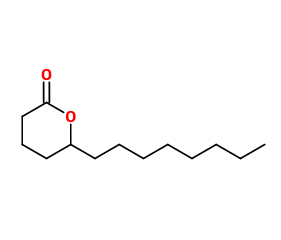
Photo credits: ScenTree SAS
| Company | Ingredient Name | ID | Comments | Naturality | Certifications | Purity | Latin name | Treated part | Geographical origin | MOQ |
|---|---|---|---|---|---|---|---|---|---|---|
|
|
(R) GAMMA DODECALACTONE | M_0066060 |
Visit website
|
Naturel | - | - | - | - | - | |
|
|
(S) GAMMA DODECALACTONE | M_0055437 |
Visit website
|
Naturel | - | - | - | - | - |
General Presentation
-
CAS N° : 2305-05-7
-
EINECS number : 218-971-6
-
FEMA number : 2400
-
FLAVIS number : 10.019
-
JECFA number : 235
-
Appearance : Colorless liquid
-
Density : 0,935
-
Volatility : Base
-
Price Range : €€€
Physico-chemical properties
-
Molecular formula : C12H22O2
-
Molecular Weight : 198,31 g/mol
-
Log P : 3,55
-
Fusion Point : Donnée indisponible.
-
Boiling Point : 311,45°C
-
Detection Threshold : Donnée indisponible.
-
Optical rotation : Donnée indisponible
-
Vapor pressure : Donnée indisponible
-
Refractive Index @20°C : Donnée indisponible
-
Acid Value : Donnée indisponible.
-
Flash Point : 110°C
Uses
Uses in perfumery :
Used to bring warm, creamy facets. Very good with fruity notes. Also used to ''smooth '' a accord.
Year of discovery :
Data not available.
Natural availability :
Data not available.
Isomerism :
Gamma-Dodecalactone has an asymetric carbon. Nevertheless, we always use its racemic mixture in perfumery. Delta-dodécalactone is an isomer of Decalactone-Gamma, which has one less carbon atom into its ring, but one more in its ramified carbon chain. The resulting odor changes from a metallic peach and coconut odor to a fruity peach odor
Synthesis precursor :
Gamma-Dodecalactone is not a precursor to the synthesis of another compound of olfactory interest.
Synthesis route :
Gamma-Dodecalactone is part of the gamma-lactone family: cyclic esters whose ring is made up of five atoms. This molecule is a cyclic lactone synthesized in the similar way as other lactones. The reaction between acrylic acid and butanol, in the presence of an alkaline sulphate or phosphate allows this molecule to be synthesized. Intramolecular esterification of 4-hydroxyheptanoic acid, catalyzed by a strong acid such as concentrated sulfuric acid, also makes it possible. Finally, biochemical synthesis routes are being studied by the producing companies.
Regulations & IFRA
Allergens :
This ingredient does not contain any allergen.
IFRA 51th :
This ingredient is not restricted for the 51th amendment

